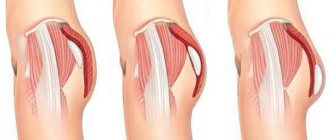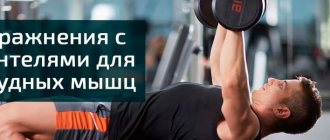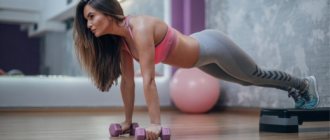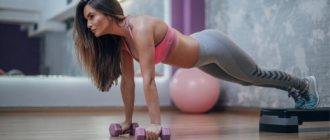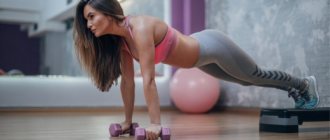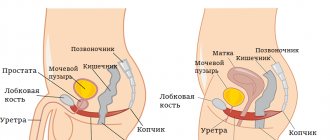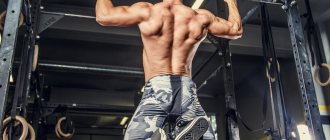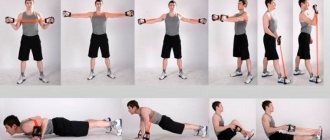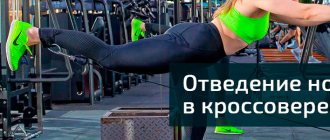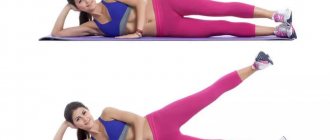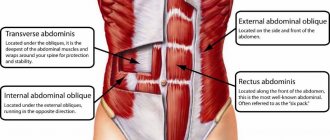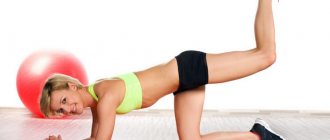- August 3, 2018
- Workouts in the gym
- Alisa Frolova
The times when a girl could have flabby muscles and still be considered attractive are long gone. And now beautiful, slender and toned bodies have come back into fashion. Therefore, all young people and many of those who are older rushed to the gyms to get themselves, if not in perfect, then at least in decent shape. However, some people found this idea not very convenient, and they switched to classes at home. Fortunately, you can find a whole bunch of video tutorials on the Internet. But it’s not always possible to choose the right option among them. And all because many of them are recorded by professionals, who are much better prepared than beginners, and use strange and incomprehensible terms for people far from sports.
Of course, some guys and girls prefer not to bother themselves and love their real selves. But elastic and pumped up bodies put pressure on the psyche with such force that they still encourage action. A firm butt, which could be compared to a nut, is considered especially popular and mandatory for everyone. In this article we will tell you in detail and clearly about how to pump up the lateral muscles of the buttocks and achieve the ideal result yourself at home.
Important preparatory stage
Before starting any workout, it is important to prepare a comfortable outfit. It's best if it's sportswear. As a last resort, you can wear pants and a T-shirt that do not restrict your body and allow you to perform various movements. Based on the advice of professional trainers, the optimal time for physical activity is the evening hours. From about six to eight in the evening. Half an hour before training, you need to drink 200 ml of pure still water. It is better to eat no later than an hour before exercising for the buttocks and other parts of the body. It is also recommended to arrange the place where the sporting event is planned. Ideally, the space should be large and have a mirror, thanks to which a person can monitor the correctness of his movements.
A huge number of people are convinced that in order to achieve the best results in the shortest possible time, you need to choose the most difficult, and therefore barely feasible, workout for yourself. And this is a big mistake. After all, excessive load has a detrimental effect on the entire body: in addition to the fact that the muscles get tired and the whole body hurts, a person can cause irreparable harm to the joints and internal organs. It is worth paying special attention to this point, because any exercise should only bring benefits.
Another mistake that beginners often make is not warming up. According to experts, any exercises for the buttocks, abdomen, chest and other things should be preceded by a preparatory stage. Moreover, it is not only the part that needs correction that needs to be developed. Therefore, below we offer the reader a very simple but effective warm-up. It will take no more than 10 minutes, but will perfectly prepare the muscles and the body as a whole for training.
A number of benefits of working out the legs:
- Strengthening the core and creating a stable and durable muscle corset
- Progress in increasing muscle size
- Some development of the upper body muscular system
- Strengthening the whole body, preventing arthritis and osteoporosis
- Protection against injury or damage to the knee joints
- Development of a beautiful and symmetrical body
- Increase in total body weight
- Positive effects on heart health
- Vessel cleaning
- Shaping the gluteal muscles (relevant for women)
- Improving neuromuscular communication between muscle cells and the brain
- Accelerating the production of sufficient amounts of testosterone and somatropin
I suggest you familiarize yourself with the Anatomy of the muscles of the shoulder joint.
0
Warm-up before pumping the buttocks
The exercises should be performed at a moderate pace, trying not to make sudden movements. Our task is simply to prepare the body and muscles for further training. Therefore, in this case, quality is much more important than speed. So let's get started:
- We take a comfortable position - feet shoulder-width apart, arms hanging freely at the sides.
- Raise your chin up, then move it to its normal position and lower it to your chest. We repeat this and subsequent exercises 3 times.
- Ear to the left shoulder, head straight, ear to the right shoulder.
- Turn your head left, center, right.
- We draw a rainbow in the sky - we move our nose from the left shoulder to the right, then back.
- Circular movements of the head to the left.
- Circular movements of the head to the right side.
- Rotate your shoulders back.
- Rotate your shoulders forward.
- We spread our arms to the sides and move our shoulders forward, to the center, back and again to the center.
- Without lowering your arms, rotate your shoulders forward, and then also back.
- Rotate your arms at the elbows, first forward, then back.
- Rotate your arms at the wrists back and forth.
- We draw a circle in the air with our hands forward and backward.
- We move the chest to the left, then back, right, forward.
- We make circular movements with the chest through the right side.
- We move the chest to the right, back, left, forward.
- We make circular movements with the chest through the left side.
- Now we move on to warm-up exercises for the lateral muscles of the buttocks and waist. We repeat them 5 times in each direction.
- Move the pelvis to the left, then to the right.
- We move the pelvis forward, left, back, right.
- We rotate the pelvis through the left side.
- We move the pelvis forward, right, back, left.
- We rotate the pelvis through the right side. Moreover, it is important to note that the hip rotation exercise tightens the buttocks, corrects the waist, and pumps up the muscles in the abdomen, thighs and legs.
- Now we put our feet together and step in place, alternately raising the left foot, then the right, on the toe. Moreover, it is important to spring.
- We squat slightly, rest our hands on our knees, make a circle with our kneecaps across the left side and stand in the starting position.
- Then we repeat the exercise through the right side. You need to squat as low as possible and make the circle as wide as possible.
- Again, place your feet shoulder-width apart and step from left to right, then back.
- We take a deep breath, raise our arms up to the sides, lower them and exhale.
- We also raise our hands up, inhale, lower them - exhale, stretch our fingers to the floor, fix the position for 10 seconds and straighten up.
The warm-up described above will help prepare the body and muscles. After this, you can move on to studying the question of how to pump up the lateral muscles of a girl’s buttocks.
Muscles of the back of the thigh:
The muscles of the hamstrings include:
- Biceps muscle - presented in the form of long and short heads. Responsible for the process of flexing the tibia at the knee joint (provided the pelvis is fixed). The biceps muscle originates from the ischium and stretches all the way to the head of the fibula at the knee
- Semimembranosus muscle - Inserts at the edge of the tibia. This muscle flexes and allows rotation of the lower leg, and is also involved in hip extension.
- Semitendinosus muscle - Inserts on the medial surface of the tibia. Takes part in the process of flexion of the lower leg, and also participates in hip extension
The muscles of the back of the thigh perform the following functions:
- Flexion at the knee joint (main function)
- Possibility of internal rotation of the knee joint
- External rotation
- Hip abduction
The best exercises for the hamstring muscles:
Classic squats
According to experts, various types of squats are considered the most effective and most effective exercises for correcting the buttocks. However, they must be performed correctly. Otherwise, all efforts may be in vain.
In this article, we will first examine the standard squat. To perform them, if desired, you can prepare dumbbells. There is no need to take it too heavy. For beginners, the ideal option is a projectile of one or two kilograms. If you don’t have dumbbells and don’t want to buy them, you can use half-liter bottles filled with water. You can also do without weights. But then the training will be more gentle.
So, how to pump up the lateral muscles of the buttocks using classic squats:
- Take a stance: feet shoulder-width apart, upper body slightly tilted forward.
- The arms, bent at the elbows, are in front of the chest, the hands are squeezed one projectile at a time.
- We squat, trying not to slouch and keep our back parallel to our shins. We don’t lower our heads, we look ahead.
- We repeat the exercise 5 times, then put the dumbbells aside, take a deep breath, raising our arms, exhale, lowering our arms, and repeat the exercise 5 more times.
- Professional trainers advise doing the first set at a slow pace, the second at a moderate pace.
How does it work?
The position of our body is supported by a cylinder-like muscular frame (core). Its walls are made up of the transverse, oblique and rectus abdominis, multifidus (deep dorsal muscles) and erector spinae muscles. The cylinder is closed from above by the diaphragm, and from below by the pelvic floor muscles. It is a three-layer muscle plate stretched like a hammock from the pubic bone in front to the tailbone in the back. The thickness of the plate is about 1 cm. If all the pelvic floor muscles contracted individually, they would pull in different directions. However, they work together to support the bladder and intestines, the prostate in men and the uterus in women, and therefore partly control the functioning of these organs. In addition, the pelvic floor muscles strengthen the rectal sphincter and urethra (Fig. 1).
Contractions of the pelvic floor muscles can be regulated by volition, but usually they contract unconsciously, in coordination with the work of the deep muscles of the abdomen and back and the diaphragm and help control pressure in the abdominal cavity during physical activity. In an ideal situation, intra-abdominal pressure is automatically regulated. For example, when lifting a weight, the core muscles work in ensemble: the pelvic floor muscles rise, the abdominal and back muscles retract to support the spine, and breathing is not difficult. If any of the core muscles, including the pelvic floor muscles, are weakened or damaged, automatic coordination is impaired. Then, in situations that increase intra-abdominal pressure, there is a possibility of overload of the pelvic floor, it weakens and the pressure decreases. If this happens repeatedly, the stress on the pelvic organs increases over time, which can lead to loss of bladder or bowel control or pelvic organ prolapse.
To work as part of the core, the pelvic floor muscles must be flexible, meaning they can not only contract and hold tension, but also relax. Constant tension can cause the muscles to lose flexibility and become very stiff, and pelvic floor muscle stiffness is usually associated with weakness, which can lead to urinary incontinence, pelvic pain, pain with intercourse and difficulty urinating.
Single leg squats
These exercises are considered much more complex, but also effective. The execution technology is similar to the previous one. But at first it is recommended not to use weights in order to adjust the quality of the exercises. It should be borne in mind that it is important to perform exercises on each leg. That is, first squats are carried out with raising the left leg, and then the right.
So, we pump up the gluteal muscles with one-leg squats:
- We place our feet shoulder-width apart, slightly tilt our upper torso forward, trying to keep our shoulders and knees in the same vertical line.
- We bring our right leg back, pressing it towards the buttocks and holding it with our left hand.
- The right hand can be used to maintain balance.
- The back is straight, the neck is straight, we look straight ahead.
- Slowly sit down on your left leg and just as slowly rise to the starting position.
- Repeat the exercise 5 times and change legs.
- We press our left leg to our buttocks, support it with our right hand, carefully sit down, then rise.
- Repeat 5 times.
How to make your butt big and pumped up
It is known that there is such an irresistible thing as hereditary predisposition. If a woman has a narrow pelvis, then training will not make it wider. And vice versa, if a man’s pelvis is wider than he would like, not a single gym will be able to narrow it. The shape of the butt depends mainly on the parameters of the gluteus maximus muscle, quite a bit - on the middle muscle, and practically does not depend on the gluteus minimus muscle. By the way, the length and width of the muscle cannot be changed either - genetics does not allow it. But you can pump up your butt and remove excess fat. That is, to a certain extent, increase muscle mass and “dry out” excess deposits. But everything is good in moderation: one admires elasticity, not thinness; Flabbiness is what disgusts, not fullness.
It is impossible to get an attractively shaped butt, although you can inherit it, but it won’t last long. The most reliable way is training. Moreover, to get a beautiful butt, experts advise pumping the upper, lower and lateral sectors of the buttocks separately. This allows you to form the surface with great precision, hide imperfections and bring the shape closer to the ideal. Next, we will look in detail at how to change specific areas of the buttocks.
Lunges forward and backward
To pump up the gluteus medius and maximus muscles, professional trainers recommend doing various types of lunges. At home, they are quite doable even for beginners. To tighten your buttocks, you should lunge forward and backward. Lunge jumps are also very effective. But they require good physical training. Therefore, masters do not advise beginners to experiment with them. At least at first.
Forward lunges should be performed on each leg 10 times:
- We stand straight, hands on the waist, feet shoulder-width apart, gaze directed forward.
- We take a step forward with our left foot, trying to move it as far as possible from the right, but not allowing the right knee to drop to the floor.
- Then we change legs and step forward with the right one.
- Back lunges are performed in much the same way. The only difference is that the step is taken in the opposite direction. You need to repeat the movements 10 times on each leg.
These exercises allow you to use the middle and large muscles of the pelvis and the back of the thigh. For beginners, they are very effective, but if the reader is interested in how to pump up the lateral muscles of the buttocks using jumping lunges, then we will explain the technology below:
- The pose should be the same as in the previous exercises.
- Jumps are performed in place, moving one leg as far forward as possible and the other as far back as possible.
- Then the position changes, but this must be done while jumping.
In this case, not only the gluteal muscles are involved, but also the hip and calf muscles. Therefore, you will be able to tighten your buttocks, legs and lose a few kilograms through physical activity.
Medium and small muscles
In humans, the gluteal fibers are quite well developed. The abnormally large size of this group allows the body to be held in an upright position. The middle muscle begins on the outer part of the ilium. The beginning is the gluteal aponeurosis. The fibers end in the form of a tendon, which is attached to the side of the hip joint. The minimus muscle begins between the lower and anterior parts of the gluteal line from the ilium. The small fibers in the posterior part pass from the ischial muscle and attach to the hip joint.
Swing your legs back
To perform the next exercise for the lower buttocks, you will need to get on all fours so that the emphasis is on your palms and knees. Your hips and arms should be positioned strictly perpendicular to the floor. Keep your back straight, do not slouch or arch. You need to look at the floor without bending your neck. We perform the actions simultaneously: we move our left arm forward and pull our right leg back. We strive to raise them as high as possible so that the arm, back and leg form a straight line parallel to the floor. Then lower the limbs to the starting position. We repeat the exercise 10 times, keeping the pace even. Then we perform similar actions, but with the opposite arm and leg.
Backward leg swings help engage the gluteal muscles, particularly the lower part. This will help tighten your buttocks and make them more rounded and firm.
How to tighten your lower buttocks
Muscles need tone, otherwise, when the load decreases, they become flabby and begin to sag. The reason for this may be not only the cessation of training that has already become habitual, but also the emergence of bad habits, a predominantly sedentary lifestyle, and a sharp change in weight.
How to tighten your butt from below? In short, by eliminating the causes of sagging soft tissues:
- remove excess fat;
- move more;
- leave bad habits;
- restore training.
These measures are usually sufficient. However, if you urgently need to tighten the bottom of your buttocks, then we recommend using strength exercises and specific walking:
- deep lunges with dumbbells - keep your back vertical;
- squats with dumbbells with legs wide apart;
- deadlift with dumbbells;
- walking uphill.
The last of the proposed exercises is best performed on a treadmill or on an ellipsoid, setting the inclination angle to at least 9–12%. The weight of dumbbells, the number of repetitions and approaches are indicated in the table at the beginning of the article. As you can see, making your butt big and pumped up is a doable task, and you can handle it.
Gluteal bridge
A very simple but useful exercise for girls for the round gluteal muscles. To complete it you need:
- Lie on your back with your arms parallel to your body, palms facing down.
- Legs should be bent at the knees, feet should be moved towards the pelvis so that the shins are perpendicular to the floor.
- You also need to monitor the position of the body; it should form a straight line.
- Head and neck on the floor, gaze directed upward.
- Moreover, it is important to pay attention that the emphasis of the body must be transferred to the feet and shoulder blades. But in no case on the neck.
- We fix the position for 30 seconds.
- Then we lower our legs, spread them slightly and arms to the sides, turn our palms up - rest for 10 seconds.
- We do two more approaches, not forgetting about rest, and move on to the next exercise.
Critical coccyx fractures
The most complex mechanical injuries cause damage to internal organs. What are the consequences of critical coccyx fractures?
- Bladder bruise, in severe situations there may be a rupture. Characterized by severe pain, blood in the urine, difficulty urinating, fever - clinical signs of bladder problems.
Bladder rupture is accompanied by characteristic symptoms - Damage to the uterus. Blood clots are released, aching pain around the pubis. The genitals are bursting, there is a feeling of tension and pressure.
- Damage to the rectum. Red or brown stool, pain during bowel movements. Constipation may occur regardless of the food consumed.
- Irritation of nerve endings. Fractures can cause not only irritation, but also damage or rupture of nerves. The pathology is characterized by very strong pain, the patient may experience painful shock. The functionality of the pelvic organs and lower extremities is impaired. Sensitivity decreases, visible deviations in physiology are noticeable.
Consequences and symptoms of a coccyx fracture
In all cases of internal bleeding, you should consult a doctor as soon as possible. Only after diagnosis is the optimal treatment regimen prescribed; in particularly difficult cases, it is necessary to stay in a medical facility under the constant supervision of doctors.
Wall stand
How to pump up the lateral muscles of the buttocks if there is no time for long-term training? This question is asked by most young mothers with infants in their arms. And experts offer a worthy answer that will appeal to many sloths. However, do not underestimate this activity. Behind the apparent simplicity and ease lies a very effective and efficient exercise. It is notable for the fact that it trains not only all the gluteal muscles, but also the back and inner thighs, calves, abs, and also forms correct posture.
To complete it you need:
- Go to the wall and lean your back against it.
- Move your feet forward.
- Do a test squat.
- If the exercise is performed correctly, then the head, neck, shoulders and the entire surface of the back and hips will seem to be pressed into the wall. And the shins are located perpendicular to the floor. If the situation is different, it should be corrected.
- Then we fix our body for 30 seconds. If it becomes very difficult, the period can be reduced to 15 seconds. You will have to endure them, even if the muscle pain seems unbearable.
This exercise for girls for round buttocks is one of the most effective. Therefore, you can expect results after a week of daily training.
Anatomy of human legs:
4 main groups of lower extremities:
- Buttocks
- Anterior thigh
- Posterior thigh
- Calf muscles
The muscles of the legs are quite long in structure and have a great extent. There are also small muscles that are designed to help their big brothers rotate joints and maintain body balance. It is also interesting that the smaller leg muscles, together with the larger ones, can support our posture.
Exercises with a step platform
According to professional trainers, steps on the stairs are considered very effective for pumping up the gluteal muscles. For this reason, residents of high-rise buildings can be recommended to “travel” from the apartment on their business and back not by elevator, but on foot. It’s also great to have a special step platform in your home. It can be purchased at any specialized sporting goods store. There are a lot of exercises with this apparatus. However, the most effective, but also difficult, is considered to be jumping onto a stand from a saddle. To do it correctly, you must:
- Stand near the step platform with your feet shoulder-width apart.
- Clasp your hands at the elbows and bring them together in front of the chest, elbows pointing down.
- Bend your upper body forward so that your shoulders and knees are at the same level.
- Now we do a deep squat, trying to get our thighs parallel to the floor.
- We fix the position of the body. It should not change throughout the lesson.
- Then we make a dash and jump onto the step platform.
- Then we jump back. Keep your back straight and look ahead.
- Repeat 10 times.
If this exercise seems very difficult, at first you can do stepping onto the stand. It is not difficult to perform, and the video instructions presented below will help you verify this.
Calf muscles:
These muscles, which are located one above the other, are called the soleus and gastrocnemius, or, more simply, the triceps muscle.
The muscles of the lower leg include:
- The gastrocnemius is a biceps calf muscle that originates from the femur and extends downward where it attaches to the Achilles tendon. The gastrocnemius muscles are an order of magnitude larger than the soleus muscles.
- Soleus - presented as a large and flat muscle that originates from the tibia and fibula bones, then goes down where it attaches to the Achilles tendon. This muscle is located under the gastrocnemius muscle, and is an order of magnitude smaller than it
- Plantar - This relatively small muscle has a long tendon. It originates from the lateral line of the thigh (supracondylar). This muscle is located between the gastrocnemius and soleus muscles. In 10% of cases, people do not have it at all
- Anterior tibial - Originates from the tibia. It allows the process of extension of the foot, as well as its supination
The muscles of the lower leg perform the following functions:
- Flexion of the foot and ankle
- Rotate the shins inward
- Extend and supinate the feet
The best exercises for the calf muscles:
Exercises with a chair
It's no secret that many girls can't bring themselves to do difficult workouts. However, to strengthen and pump up the gluteal muscles, professional trainers recommend doing a fairly simple exercise. It is convenient because it does not require sports equipment. But it helps to achieve excellent results in the shortest possible time. The main thing is to find a stable chair with a high back in the house. When the required projectile is found, you can move on to studying the technology.
So, how to pump up the gluteus minimus muscle:
- We approach the chair from the back side.
- We hold the back with our hands, the whole body is stretched out.
- Raise one knee up and count to 5.
- We tilt the body forward, transferring the center of gravity to the hands, and move the leg back, trying to keep it parallel to the floor.
- We bend the leg at the knee, then straighten it.
- Repeat 10 times.
- Then we straighten up again and pull the leg, compressed at the knee, towards the stomach.
- We count to 5 and place our foot on the floor.
- We perform similar manipulations with the opposite leg.
Symptoms of pelvic floor muscle dysfunction
- Uncontrollable leakage of urine when exercising, laughing, coughing or sneezing (stress incontinence).
- The need to go to the toilet frequently or urgently (urge incontinence).
- Incontinence of gases and intestinal contents.
- Difficulty emptying your bladder or bowels.
- Prolapse of internal organs. In women, it is felt as a bulge in the vagina or a feeling of discomfort or heaviness. In men, there is a bulge in the rectum or a desire to empty the bladder, although there is no objective need for this.
- Pain in the bladder, bowel, or back near the pelvic floor when doing pelvic floor exercises or during sexual intercourse.
Experts emphasize that the above problems are not necessarily associated with weakness of the pelvic floor muscles, so their cause should certainly be found out. Diagnosis is carried out using electromyography, ultrasound or MRI.
Video training for butt lift will come to the rescue
And finally, we would like to invite readers who perceive information better visually to find a set of exercises that is effective for you.
It should be performed at home using available means. The workouts are notable for the fact that in addition to pumping up the buttocks, they help to correct the waist, abdomen and hips. The complex takes no more than 15 minutes, but the result will definitely please you.
So, now our reader knows everything about how to pump up your buttocks. From the side, the result will look great. You just need to set a goal and persistently move towards it.
Mechanical damage to the coccyx
Most often, bruises occur, and fractures are much less common, but patients do not always visit medical institutions to make an accurate diagnosis. The damaged areas heal independently, which may cause a violation of the spatial position of both the coccyx as a whole and its individual sections. Depending on the force of the impact, fractures may be displaced or non-displaced. Accordingly, displacement injuries require much more time to heal; in addition, there are risks of improper fusion with all the negative consequences. In addition to fractures, mechanical injuries can result in dislocations of the joints in the coccyx and ruptures of the cartilage tissue between the vertebrae and the coccyx.
Symptoms of a tailbone injury
Treatment
The main methods of treatment are autogravitational traction of the spine and Karipain electrophoresis on the lumbar region - if the cause of muscle damage is a violation of its innervation, and massage and manual therapy - if problems in the muscle are associated with prolonged violation of posture and improper load when walking. This muscle belongs to the group of muscles in the body that are prone to weakness, that is, to maintain normal tone, it needs regular training.
If the patient, after a course of treatment, when all trigger points in the muscle have been eliminated, its innervation and blood supply have been restored, does not engage in physical exercise, the weak gluteus maximus muscle will not be able to work fully for a long time, and gradually trigger points will form in it again, which means it will return and pain.
Get a free consultation by phone
